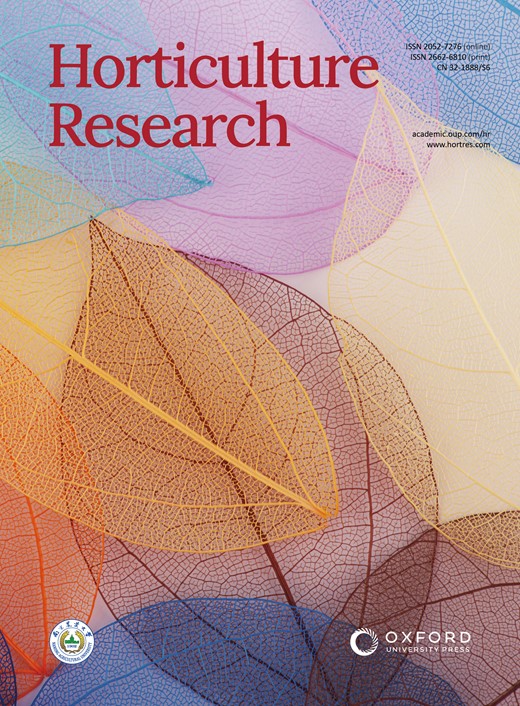梨驯化过程中有害突变及其对农艺性状影响的基因组学见解
IF 8.5
1区 农林科学
Q1 Agricultural and Biological Sciences
引用次数: 0
摘要
梨(Pyrus spp.)是一种多年生果树,经过几十年甚至几个世纪的遗传改变,以适应复杂的气候和栽培条件。对多年生果树有害突变的全基因组研究仍然有限,特别是关于驯化对有害突变的影响。本研究对232份梨材料进行了全基因组重测序,共鉴定出9909773个snp位点和139335个有害突变位点。在梨基因组中,编码区有害突变的比例(1.4%)高于一年生作物。在驯化过程中,发现P. pyrifolia / P. bretschneideri有害突变的减少与它们在选择性扫描区域的减少有关。相反,观察到群落有害突变数量的增加,这可能与选择性扫描区域内的高发生率有关。在乌苏里亚种中,有害突变总体呈增加趋势,这与驯化或基因渗入无关,而是与其相对较高的杂合性有关。在驯化过程中发现了差异有害突变基因(ddmg)。其中,通过GWAS鉴定出与石细胞合成相关的PyMYC2基因,PyMYC2在梨愈伤组织中过表达显著促进木质素的生物合成,PyMYC2包含三个在亚洲梨驯化过程中被选择的非同义有害突变。该研究为未来发展改良农艺性状的育种策略提供了新的见解,并为多年生果树驯化过程中有害突变模式的研究提供了框架。本文章由计算机程序翻译,如有差异,请以英文原文为准。
Genomic insights into deleterious mutations and their impact on agronomic traits during pear domestication
The pear (Pyrus spp.), a perennial fruit tree, is subjected to genetic alterations over decades or even centuries to adapt to complex climatic and cultivation conditions. Genome-wide studies of deleterious mutations remain limited in perennial fruit trees, particularly regarding the effects of domestication on deleterious mutations. In this study, 232 pear accessions were resequenced, and 9,909,773 SNPs, and 139,335 deleterious mutation sites, were identified genome-wide. A higher proportion of deleterious mutations in coding regions (1.4%) was observed in the pear genome than annual crops. During domestication, a reduction in deleterious mutations in P. pyrifolia / P. bretschneideri was found to be associated with their decreases in selective sweep regions. Conversely, an increase in the number of deleterious mutations in P. communis was observed, which may be related to a higher occurrence within selective sweep regions. In P. ussuriensis, an overall increasing trend in deleterious mutations was identified, which was determined to be unrelated to domestication or gene introgression but instead linked to its relatively high heterozygosity. Differential deleterious mutation genes (DDMGs) were identified during the domestication process. Among these, the PyMYC2 gene, associated with stone cell synthesis, was identified through GWAS, overexpression of PyMYC2 in pear callus significantly promoter lignin biosynthesis, PyMYC2 contains three nonsynonymous deleterious mutations that were selected during the domestication of Asian pears. This research provides new insights for developing future breeding strategies aimed at improving agronomic traits and offers a framework for studying deleterious mutation patterns in the domestication of perennial fruit trees.
求助全文
通过发布文献求助,成功后即可免费获取论文全文。
去求助
来源期刊

Horticulture Research
Biochemistry, Genetics and Molecular Biology-Biochemistry
CiteScore
11.20
自引率
6.90%
发文量
367
审稿时长
20 weeks
期刊介绍:
Horticulture Research, an open access journal affiliated with Nanjing Agricultural University, has achieved the prestigious ranking of number one in the Horticulture category of the Journal Citation Reports ™ from Clarivate, 2022. As a leading publication in the field, the journal is dedicated to disseminating original research articles, comprehensive reviews, insightful perspectives, thought-provoking comments, and valuable correspondence articles and letters to the editor. Its scope encompasses all vital aspects of horticultural plants and disciplines, such as biotechnology, breeding, cellular and molecular biology, evolution, genetics, inter-species interactions, physiology, and the origination and domestication of crops.
 求助内容:
求助内容: 应助结果提醒方式:
应助结果提醒方式:


